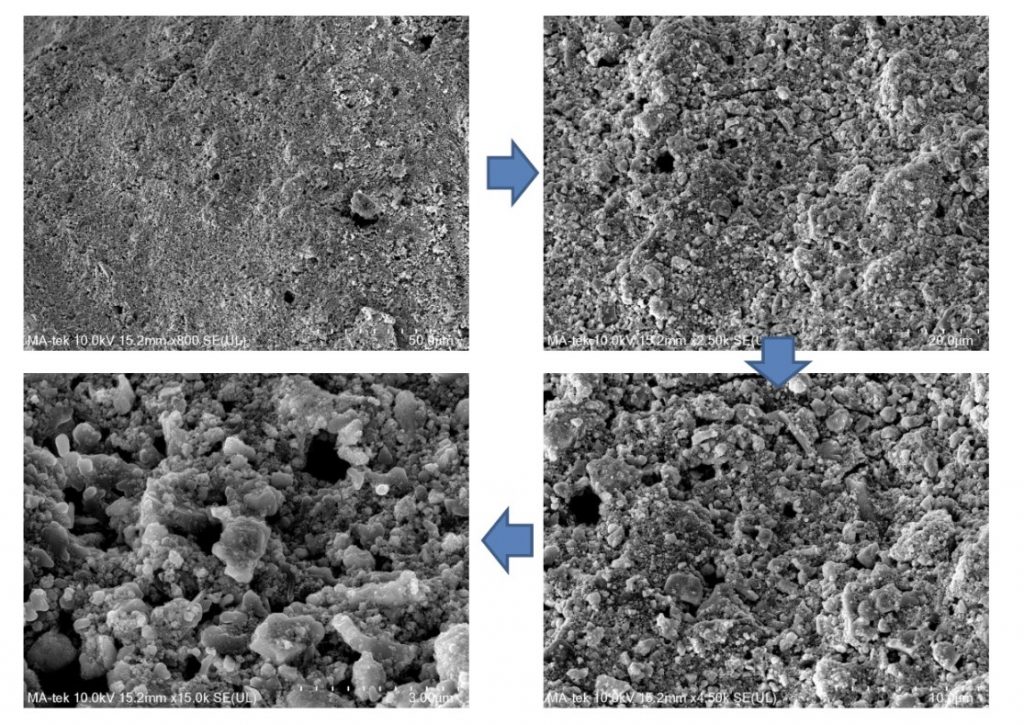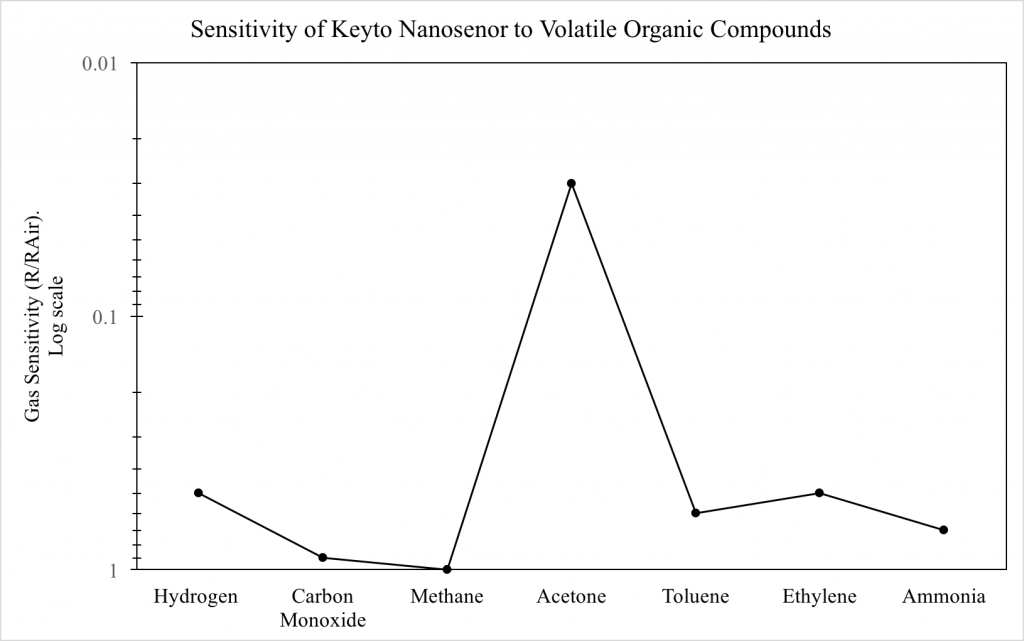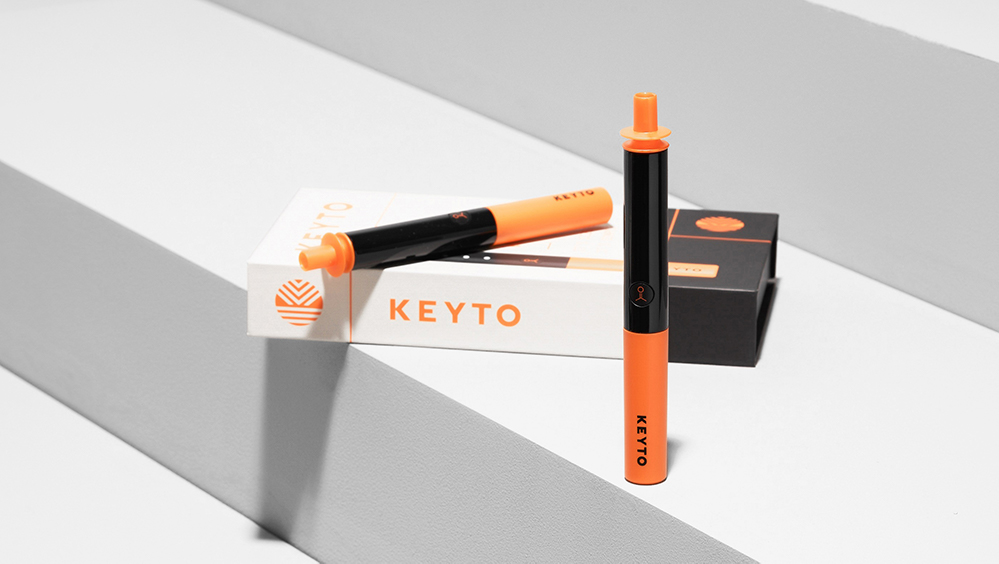Goal
The Keyto is a breath sensor that is designed to help users reliably answer the questions “How much fat am I burning right now?” and “Am I in ketosis?” It does this by detecting the level of a specific biomarker, acetone, in a user’s breath.
Biology
Why measure acetone? Let’s begin with how ketones are made in the liver. The starting material is fatty acids either derived from the diet or mobilized from adipose (fat) tissue. These fatty acids are produced from enzymes breaking down fat stores at times of need, such as fasting, starvation or exercise. The fatty acids are transported by blood to the liver where they are oxidized (burned). The product of this oxidation is a chemical called acetyl-CoA. Acetyl-CoA is critical source of fuel for our cells and our bodies. It delivers the acetyl group to the citric acid cycle (Krebs cycle) to be used for energy production.
When glucose (sugar) levels are very low, there can be an excess of acetyl-CoA from fatty acids which overwhelms the cellular machinery of the Krebs cycle. This causes shunting of acetyl-CoA to an alternative pathway, the ketogenesis (ketone production) pathway. When this happens, the liver begins to make ketones. This is an ancient mechanism that evolved within humans to protect us from starvation when food was scarce. Humans can live for months with zero calories from food because we have adapted this mechanism to convert fat stores into energy that our brain, heart, and other tissues can use.
How does this happen? The simplest way to think about this is that 2 acetyl-CoA molecules combine and eventually result in formation of a new molecule called acetoacetate.

Acetoacetate is the first of what typically are referred to as ketone bodies. It is broken down by enzymes to two other molecules. The first of these is called β-hydroxybutyrate. It is the “ketone body” measured in most blood tests for ketones. The second is acetone.

Keyto detects acetone, which is expelled through the breath. Through it we can determine the level of fat utilization and level of ketosis for a given user using our breath sensor.

Keyto Breath Acetone Sensor
Every Keyto has a proprietary nanosensor that is selective to acetone. The sensor consists of a metal oxide core, composed of a specific, proprietary combination of elements that make the sensor selective for acetone. The metal is arranged in nanoparticles with oxide surrounding the outer layer.
The below image shows a planar view of the sensor surface, in progressive zoom, from a scanning electron microscopy:

The process to make the sensor includes extensive human and machine processing. Every sensor goes through multiple rounds of assembly, validation, aging, and calibration.
In addition to the sensor itself, there is a coil inside of the metal for heating before measurement, giving the sensor a better sensitivity profile.

How the sensor works
When acetone gas contacts the sensor, it reacts with the metal compounds, which affects the oxide surrounding each nanoparticle. This increases the conductivity of the metal (oxide is an insulator) which decreases resistance and produces a current.
The level of current produced during a breath measurement is turned into a digital signal. This digital signal is received by a microcontroller, and transmitted to the app via Bluetooth. Through an algorithm derived from machine learning techniques, the app then converts the digital signal into a Keyto Level.
Through extensive research, development, and decades of experience with gas sensors, we have found the optimal metal element and oxide combination. This makes our sensor selectively reactive to acetone (and not other volatile compounds).


Testing and calibration
In developing the Keyto*, thousands of lab calibration and human tests were performed. Calibration testing is conducted with known concentrations of acetone gas, which are certified by independent labs. Human testing is done with humans in varying levels of ketosis.
The number of hours spent and data generated has been immense. In addition to researching the properties of the sensor, a nearly equal effort was spent developing the mathematical models to translate the digital signal into meaningful outputs. These models started off as advanced statistical techniques, but eventually moved into machine learning techniques.
Individual calibration: Each Keyto sensor is individually aged and then calibrated with multiple concentrations of standard acetone gas. This process is highly labor intensive, but we are committed to making sure that every single Keyto delivered is as accurate as possible.
Through all this, we have achieved high repeatability in lab calibration tests, individual tests, and across devices. The ultimate goal is to provide an experience for users that “just works.” To that end, we take pride in making this complex technical process seem simple for users.
*The testing process was led by Ethan J. Weiss M.D. and Ray H. Wu M.D. Dr. Weiss is a world known expert in preventative cardiology and metabolism as an Associate Professor at UCSF and principal investigator at the Cardiovascular Research Institute. Dr. Wu graduated with honors from the Weill Cornell Medical College and has published numerous peer reviewed scientific articles, including the molecular biology of diabetes and metabolism.
Breath acetone and fat loss
Normal people can have breath acetone of 1 ppm. Ketosis is between 2-40ppm.

Numerous studies have been performed2,3,4,5 that study the relationship between breath acetone and fat loss. Virtually all have found that as breath acetone increases, subjects lose weight and fat. While the exact amount of weight loss depends on numerous factors (starting weight, gender, time), multiple studies found that ~2 ppm breath acetone sustained over a week will results in half a pound of body fat burned during that week. These results were achieved in conjunction with a restricted caloric diet.
There is a lack of scientific studies regarding the effect that increased breath acetone levels to higher ranges has on the rate of weight loss. In addition, high levels may be achieved through other methods such as fasting, exogenous ketone supplements, MCT oils, etc, which result in utilization of varying amounts of body fat and fat from nutritional sources which makes creating specific expectations of weight and fat loss difficult.
At Keyto, we are focused on long term success. Open label clinical trials6,7 have shown that the ketogenic diet can result in long term weight loss, and a recent landmark paper demonstrated that low-carb diets have a positive effect on long term metabolic rate8.
As part of long term success, we believe that people should not be hungry nor should they focus on calorie restriction. People should eat satisfying foods until satiated, which can be done easily and with great results. We have seen this over and over again with users on the Keyto program.
The factors above explain why we chose to create Keyto Levels vs displaying PPMs. PPMs can be confusing, and give a false sense of accuracy as it relates to the amount of body fat being burned (and the results to be expected). In contrast, we have optimized the Keyto Level to deliver the information that is most relevant for our users – information that is important in their quest to achieve and maintain nutritional ketosis and lose weight.
Most importantly, Keyto Levels are simple to understand, and provide a reference for each individual user to know their current state of ketosis. This has a near-magical effect on the motivation and enjoyment levels of Keyto users.
Our users have seen an average of 5% body weight lost in the first 5 weeks on Keyto. Many have lost even more. Predictably, the exact amount of weight lost depends on starting BMI, gender, initial diet, and many other individual factors. We look forward to publishing our full data set in a scientific journal in the near future.
Citations
- Anderson JC. Measuring breath acetone for monitoring fat loss: Review. Obesity (Silver Spring). 2015;23(12):2327-34.
- Kundu SK, Bruzek JA, Nair R, Judilla AM. Breath acetone analyzer: diagnostic tool to monitor dietary fat loss. Clin Chem1993;39:87–92.
- Landini BE, Cranley P, McIntyre J. Diet and exercise effects on breath acetone concentration measured using an enzymatic electrochemical sensor. Obesity Society Annual Scientific Meeting. Obestiy Society: New Orleans, LA, 2007, pp 719.
- Triffoni‐Melo AT, Dick‐de‐Paula I, Portari GV, Jordao AA, Garcia Chiarello P, Diez‐Garcia RW. Short‐term carbohydrate‐restricted diet for weight loss in severely obese women. Obes Surg2011;21:1194–1202.
- Toyooka T, Hiyama S, Yamada Y. A prototype portable breath acetone analyzer for monitoring fat loss. J Breath Res2013;7:036005.
- Hallberg, S.J., McKenzie, A.L., Williams, P.T. et al. Effectiveness and Safety of a Novel Care Model for the Management of Type 2 Diabetes at 1 Year: An Open-Label, Non-Randomized, Controlled Study. Diabetes Ther (2018) 9: 583. https://doi.org/10.1007/s13300-018-0373-9
- McKenzie AL, Hallberg SJ, Creighton BC, Volk BM, Link TM, Abner MK, Glon RM, McCarter JP, Volek JS, Phinney SD. A Novel Intervention Including Individualized Nutritional Recommendations Reduces Hemoglobin A1c Level, Medication Use, and Weight in Type 2 Diabetes. JMIR Diabetes 2017;2(1):e5
- Ebbeling CB, Feldman HA, Klein GL, et al. Effects of a low carbohydrate diet on energy expenditure during weight loss maintenance: randomized trial. BMJ. 2018;363:k4583. Published 2018 Nov 14. doi:10.1136/bmj.k4583

